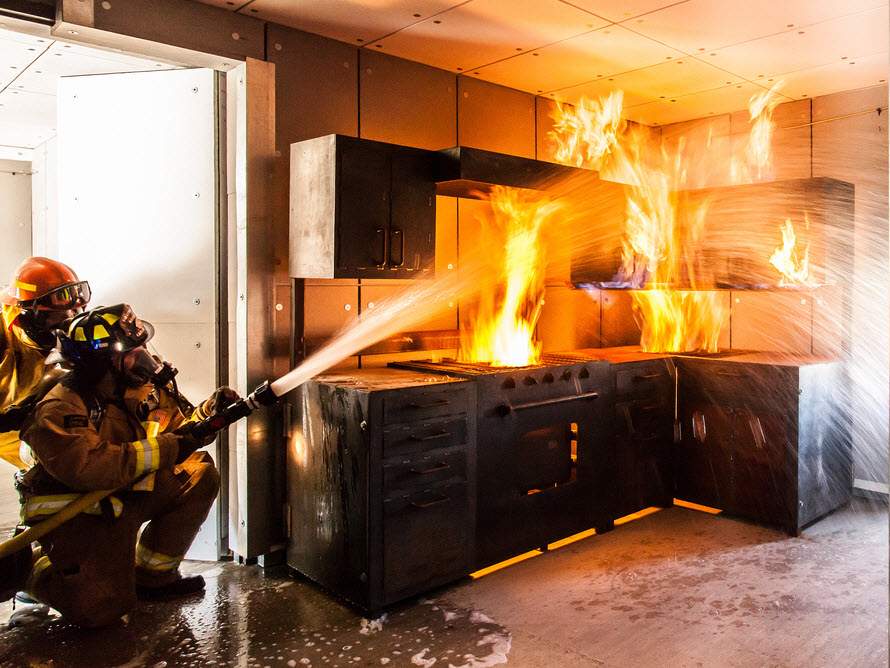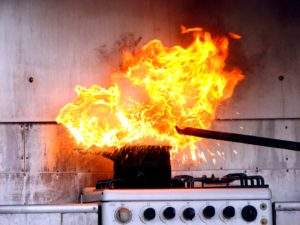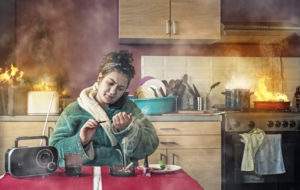Common Cooking Accidents that Cause Fire Damage

You likely know that being careful in the kitchen is pretty important. From hot pans to boiling water to sharp knives, there are few places in most homes with as much potential danger as the kitchen. But did you know that cooking accidents resulting in fires are the #1 cause of house fires in the United States?
The National Fire Protection Association (NFPA) estimates that around 173,200 home structure fires annually started as a result of cooking between 2013 and 2017 (according to their most recent report, released in November of 2019). Cooking fires alone accounted for an average of “550 civilian deaths, 5,020 reported civilian fire injuries, and $1.2 billion in direct property damage per year.” So it goes without saying that cooking fires are a very serious matter and should be avoided whenever possible.
If you have a fire emergency or have smoke damage, call Abbotts today to make an appointment for a free inspection. 303-975-4000
What Causes Cooking Fires?

The most common cause of these fires is leaving cooking food unattended. Whether this is done intentionally and something goes wrong during the anticipated cooking time, or whether the cook leaves the kitchen and forgets to return, leaving food unsupervised is the main cause of kitchen fires. Other common causes cited by the NFPA include abandoned or discarded material, a heat source too close to combustibles, unclassified misuse of material, failure to clean, and unintentionally turned on or not turned off appliances. While unattended equipment is the cause of 31% of kitchen fires, each of these other factors only account for between 7-10%, individually.
When using the stovetop, another common cause of fires is overheating oil, which causes a grease fire. This can cause a flare up very quickly, and if you don’t know how to quickly handle that sort of fire, it can spread very quickly. Similarly, when fires occur in the oven, microwave, or toaster oven when you are present, mishandling the situation can make things much worse.
How to Handle a Kitchen Fire
We will go over some basic steps to take here, but just remember that the moment you feel like a fire is out of your control, call 9-1-1 and evacuate the home.
The first type of fire you’re likely to encounter, as discussed above, is a grease fire. The best way to avoid a grease fire is to keep your cooking surfaces clean and free of fats/oils, and to make sure your oil stays at a safe temperature. When cooking with oil, allow the oil to heat up slowly and place food in gently. If you smell smoke or an acrid odor, remove the pan from the heat source immediately, as this is the step before fire.
If a grease fire does break out, follow these steps:
- Remove the heat source by turning off the burner.
- Cover the pan or pot with a metal lid or baking sheet. Use an oven mitt to protect your hand from heat as you do this. If you do not have a lid or baking sheet, use whatever you can to smother the flame, such as a towel soaked in water or the oven mitt, itself. Only use a metal lid or baking sheet, not glass, as the flame will cause the glass to shatter.
- Smother the flame with baking soda. Once you have covered the primary source of the flame, there may still be some embers, or even some flames escaping from the pan if the lid does not fit perfectly. Use baking soda to smother these. This takes a lot of baking soda, so use as much as you have available.
- Use a Class B dry chemical fire extinguisher only as a last resort to put out the fire if the previous steps have not worked.
- Evacuate the residence and call 9-1.1. Again, skip to this step at any point if the flame has grown large and gotten out of your control.
If you encounter a grease fire, do not use water under any circumstances. It will only spread the fire.
If you happen to be nearby when a fire starts inside of an oven, microwave, or toaster oven, your immediate actions are also important. Keep the door to the appliance closed to prevent the fire spreading, and turn off the heat source. Have the appliance serviced before using it again, as the fire may have damaged internal components, and it could be dangerous to use. Replace smaller, less expensive appliances such as microwaves after a fire.
What to Do to Avoid a Fire in the First Place

If you are tired, have consumed alcohol, or are taking medication that make you drowsy or forgetful, avoid cooking when you can. If you must cook, practice extra care and never leave the room. It is when we are sleepy and decide to go lay down on the couch while our pan heats up or our casserole bakes that we are asking for trouble.
Also, keep highly combustible materials away from the stovetop and other cooking appliances. Wooden spoons and cloth oven mitts should not sit on top of the stove. Also, remove anything else from the area around where you are cooking, including food packaging, towels, curtains, paper, and anything else that could possibly catch on fire.
Be careful with sleeves. While only 1% of kitchen fires start with clothing being the first item to ignite, 14% of kitchen-fire-related deaths begin with clothing. Wear short sleeves, tight sleeves, or roll your sleeves up. It only takes a moment for your loose sleeve to touch the wrong part of the stove and ignite.
After a Kitchen Fire
If you do suffer a kitchen fire, you will want to make sure you repair any kitchen fire damage fully. From damage to your home’s structure to soot and smoke damage, it is important to get all toxins safely removed from your kitchen and home before you resume normal life. Your homeowner’s insurance should work with you to bring your home back to pre-loss condition.
Getting a kitchen fire damage restoration company that is well versed in both repairing your home and handling your insurance company on your side is essential. If you are in need of fire damage repair in Denver or the surrounding areas, give Abbotts a call. We are available 24/7 in emergencies and can provide a free estimate regarding your kitchen fire damage repair.
Resources:https://www.nfpa.org/News-and-Research/Data-research-and-tools/US-Fire-Problem/Home-Cooking-Fires
https://www.nfpa.org/Public-Education/Fire-causes-and-risks/Top-fire-causes/Cooking
https://www.nationwidechildrens.org/research/areas-of-research/center-for-injury-research-and-policy/injury-topics/home-safety/cooking-safety
